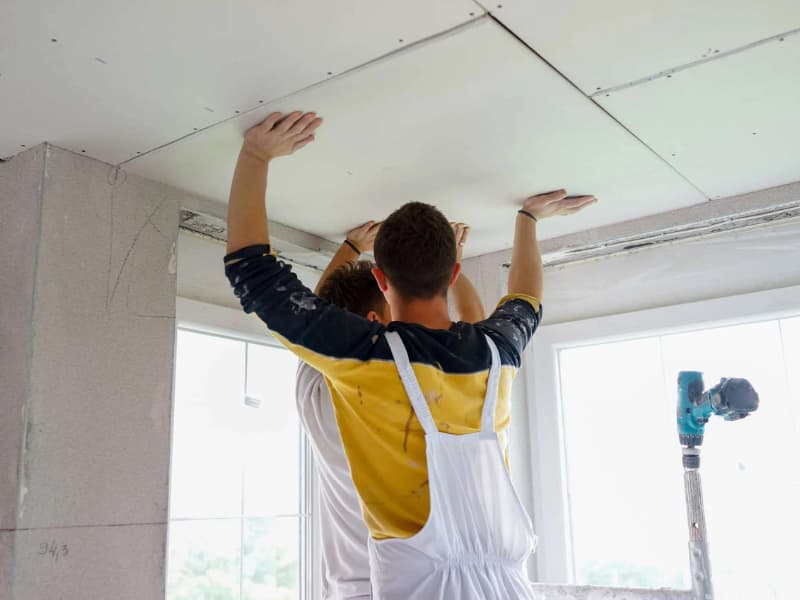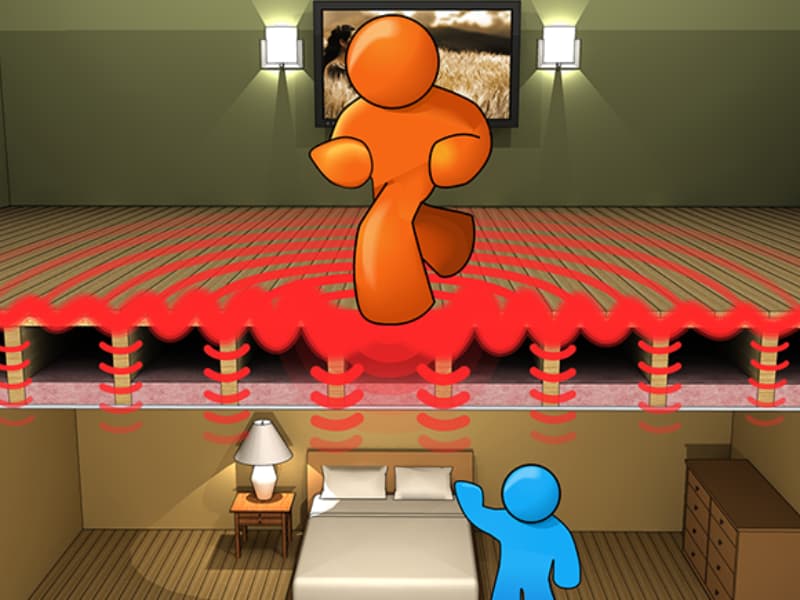When I moved out of my parents’ house, I had a single-bed apartment, and the most memorable thing (apart from the great views of the city) was the annoying neighbor upstairs. He would move the furniture, run the blender, and work out at night!
Since I worked from home, I had to find a way to stop this. This led me down the lane of soundproofing my house. However, I came across many important tidbits on what works and what doesn’t, what’s affordable and what doesn’t even cost a penny.
I realized that upstairs noises get in through building materials, air vents, ducts, staircases, doors, windows, plumbing, open spaces, and impact and refracted noises. My options were soundproofing, sealing gaps, weatherstripping, soft furnishings, acoustic panels, and talking to my neighbor.
I added rugs, carpets, curtains, and drapes, then soundproofed my home office and bedroom. I also added acoustic panels to the ceiling. The quiet that came with it was simply astonishing.

How do upstairs noises enter your house?
Upstairs noises can enter your house through various means, such as the following:
| How noise travels indoors | Fixes |
| Structure and building materials Air vents and ducts Staircases Doors and windows Impact noise Pipes and plumbing Sound refraction Open spaces and high ceilings | Soundproof the house Seal gaps Add rugs and carpets Use acoustic panels Apply weatherstripping Add soft furnishings Talk to your neighbor(s) Consider moving out |
1. Structure and building materials
Sound can travel through the floors, walls, and ceilings of a building to the lower levels. Poor insulation in the walls and floors will allow noises from above.
You will experience this in older buildings and those with lower-quality construction materials more than in newer buildings with better-quality materials. Metal roofs are also likely to create more noise than concrete roofs, for example.
2. Air vents and ducts
Do you know why the noises from above are louder when you’re close to the vents? It’s because sound can travel through vents and ducts from one floor to the other, especially when the building has shared vents and ducts.
Those upstairs will also suffer from this type of noise since sound travels up and down in almost equal measure (more downwards due to gravity).
3. Staircases
A staircase can be a sound conduit with the noise from one floor bouncing around the walls to the other floor. Think of a tunnel and how sound moves around and is even amplified in the process.
Staircase noise affects more floors than other causes since there are few barriers stopping or absorbing it.
4. Doors and windows
Upstairs noise can also enter your house through the windows and doors, whether open or closed. If they are poorly insulated or thin, the sound will still pass through them even when closed.
5. Impact noise
Impact noises like moving furniture, footsteps, dropping objects, working out, and others will also reach the lower floors.

6. Pipes and plumbing
Like air vents and ducts, sound can also travel from one floor to the next through pipes and other plumbing fixtures. More of the sound will be transmitted if the insulation around the pipes is poor and the pipes have open ends. Different types of gutters can also cause noise when impacted.
7. Sound refraction
Sound may bounce off hard surfaces and then travel through openings to give the perception that it’s coming from a different direction. Sound refraction can occur in staircases and outside the windows.
8. Open spaces and high ceilings
Sound travels more easily through homes with high ceilings and open floor plans due to the lack of barriers to stop and absorb it.
How to deal with upstairs noise
You can deal with most of these noises with different fixes and levels of difficulty. Some of the ways to get that peace into your home include the following:
1. Soundproof the house
The easiest and surest way to keep unwanted noises out is to soundproof your house. That entails insulating the walls, ceiling, floors, walls, doors, windows, and the roof. You can also add a layer of drywall to keep the noises down.
Soundproofing can be quite costly, especially when done by professionals. However, the results are excellent. I insulated my home office, and the results pleasantly surprised me. While it cost a bit, the room became so quiet and peaceful that I never regretted it.
2. Seal the gaps
Sound leakage through the walls, windows, doors, and other areas can be reduced or eliminated by sealing the gaps in these areas. While some gaps may be easily visible and easy to fix, some may require the inspection and skills of a sound expert to keep the noise at bay.
For my case, I had an expert assess the situation and then soundproof it for me. It’s better this way given that experts will have better results than if you do a DIY yourself.
3. Add rugs and carpets
You can also add carpets and rugs to your house to keep away upstairs noises. The thicker the carpet, the better it will absorb noises from moving objects and footsteps.
Since carpets will be on the floor, the noise will still get into your house, but it won’t bounce around or be amplified to form echoes. Rather, they’ll absorb the secondary noise to keep the room quiet.
4. Use acoustic panels
While the rugs and carpets will handle noise from the floor, the walls and ceilings will benefit from acoustic panels, which will keep out noise from these parts of the house.
5. Apply weatherstripping
Apply weatherstripping around your doors and windows to eliminate the noise that may come through the gaps. Weatherstripping involves adding tape to a door or window seal to keep out sound, water, or insects.
6. Add soft furnishings
Upholstered furniture, drapes, curtains, and other soft furnishings also help reduce upstairs and general noise. They absorb the little noise that may come in and prevent more of it from entering.
7. Talk to your neighbor
At times, the fix could be as easy as talking to your neighbor to reduce the volume on their music system or turn on the blender during the day and not when you’re sleeping. If they don’t cooperate after a few complaints, you can address the issue with the authorities.
With these fixes, you can have a peaceful indoors free of unwanted noises. While you can apply most of them, some will require an expert for the best results that also last. If all these fixes dont work for your case, consider moving out of that house if possible.
Frequently Asked Questions
How can I make my upstairs floor quieter?
Underlayments offer excellent noise reduction for floors by elevating the final surface away from the connecting structural elements that link the rooms. This separation effectively isolates foot noise, as the underlayment absorbs the impact and reduces the intensity of vibrations.
How do you reduce noise transfer between floors?
Install insulation, like fiberglass or cellulose wool, snugly within the gaps between the floor joists to completely fill the space. Valuable tip: Research indicates that all types of this insulation offer similar sound-absorption performance. Secure resilient channels with 24-inch (61 cm) spacing beneath the floor structure.
What is the best soundproofing upstairs floor?
The most efficient method for enhancing sound insulation between rooms involves placing acoustic batts within walls and between floors. Additional strategies encompass the use of flooring underlayment, sealing cracks with caulking, and suspending acoustic foam panels.
